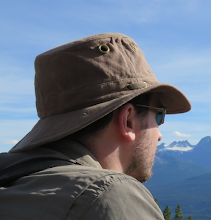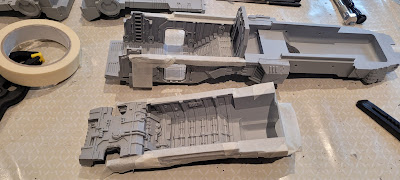After an unexpected interlude, here are the continuing adventures of building a Thunderhawk Gunship. For further context please see previous articles in this series.
Day 15
My regular roleplaying tomorrow has been cancelled, but on the bright side the weather is looking like it will finally clear, so instead of getting covered in imaginary blood I will (hopefully) be getting covered in real resin dust!
Day 16
Success! Having the Dremel in a fixed position is just so much easier to use. I got some really close neat cuts in. Just a few bits left to clean up ahead of a completely free Saturday when I hope to be able to start the main build.
Day 17
Every single piece has been cleaned. Unfortunately I also seem to be coming down with a cold.
Day 19
For having an entire free day, I didn’t get much done, but I felt like crap so at least I got something done. I sorted all the bits into “needs reshaping” and “fine as is”. Maybe about 1/4 to 1/3 needs reshaping. Filled the sink with very hot water and filled a bucket with cold water (and a bit of ice). Took a while but I went through everything and reshaped it all.
Day 20
Andy came over and we talked through structure and how best to pin everything and put the rod in for the base. It’s really useful to have a second opinion on a project like this and whilst I have been bouncing idea off the nerd herd on WhatsApp, there’s no substitute to physically having the parts in front of you and messing around with them.
On the down side, a few pieces I reshaped the day before seem to have reverted a bit to their curved shape. That’s pretty annoying.
Interlude
As Charlie mentioned in his recent post, some of us are “currently undergoing spectacular real life events”. For me this meant a big interruption, followed by intermittent opportunities to hobby. But life goes on, and progress is once again being made. Nevertheless I’ll ditch the day by day as it stopped making sense or being meaningful.
Engineering Works
With the pieces all cleaned and shaped, I was finally able to begin building this monster. But monster it is, and simply glueing the parts together was going to be a recipe for disaster. I haven’t weighed it, but this kit is heavy and I would never trust the wings to stay on without some major pinning.
Pinning is bread and butter to an experienced modeller, and if you’re not an experienced modeller you should put the Thunderhawk down and step away, however this is taking things to the next level and for this purpose I ordered some 3mm brass rod. Andy and I had already discussed where best to site the pins, so I took to drilling some holes in the hull. Once they were cut I positioned the wings in place and poked the rods through and rotated them vigorously to scratch in where I needed to drill the holes in the wing.
Next I had to take a bunch of measurements and do maths (by the gods!) to work out how long I would need the brass rod to be. It’s not like regular pins where you can just trim them to fit with wire cutters, to cut these brass rods I bought some new metal cutting discs for my trusty Dremel (other brands are available, I guess if I was on Blue Peter I’d have to cover the markings and call it a “rotary cutting tool”).
The end result was that when pushed together, the wings would stay in place even without glue (as long as you didn’t turn it sideways). Perfect! With everything prepared I was ready to attach the wings, so of course the next step was to set all of that aside…
Holey Flying Stand Batman!
The order of operations on all this is a bit crazy, so stick with me. ForgeWorld really doesn't make things easy for the modeller, and the one thing missing from this highly detailed kit is any kind of attachment for a flying stand. As such, I needed to cut a massive hole in my precious resin model. From my research I did at least know where it needed to go, right through the ventral air intake piece.
The air intake didn’t fit very cleanly onto the hull, so there was going to be a bit of a gap between intake and hull right where the hole was. As such I opted to drill the air intake part on its own, before glueing it to the main hull and then continuing the cut into that part so the location was accurate. For the sake of efficient use of time therefore I elected to first glue the two main lower hull parts together.
For all the major joins I used JB Weld Quick Setting Epoxy. Whilst it seems to have formed pretty strong bonds, the claim of setting in 5 minutes, cures in 1 hour seems to be a bit inaccurate. It definitely was sticky rather than liquid within 5 minutes but certainly not set enough for the parts to be left even under light gravity. Even after an hour I didn’t trust it so I set up a series of clamps and balanced it so that gravity would pull it into the correct alignment.
With that in place, I could then carry on with drilling out the intake with a newly acquired 1” hole cutter. I carefully measured out and drilled a small pilot hole, then clamped it up and went to it. This time I swapped out the Dremel for a proper drill.
The hole cutter came with a spring wrapped around the inner drill bit, presumably to pop out the inner piece once the hole was cut, but it started chewing up the soft resin so I had to remove it. This in turn led to the inner piece getting stuck in the cutter, so I then had to drill smaller holes into the sides of the scrap to give me purchase to pry it back out. Fun times all round.
With that done I could glue it onto the now firmly bonded main hull, and cut through that too, so the the flying stand would be deeply embedded and ultimately rest on the brass rod inside.
Paint It, Black
Yet another step to perform before glueing the wings on, mostly for convenience, was basecoating the insides. I’m not planning on submitting this to r/societyofhiddenpaint but the front flap will be openable and so I don’t want to see unpainted resin inside. I’ll give it a very basic drybrush and maybe paint a spot of metal so it doesn’t actively look bad in the background. But as such I wanted to undercoat the insides before I glued it together because spraypaint doesn't work very well spraying into holes.
I assembled all the parts that made up the interior (bulkhead, rear hatch and ladders in the lower hull, cockpit in the upper), then masked off the join areas before spraying.
Feet Pics
In between various bits of paint and glue drying, I worked on sub assemblies. The Heavy bolter turrets on the wings were assembled and magnetised. Having opted for closed air-brakes on the upper rear I manually undercoated the insides (in case the spray didn’t penetrate the small holes well) then glued the flaps in place. I sank some magnets into the front hatch and its frame so it wouldn’t fall open unexpectedly. I assembled the strike wings and the rudder. But most importantly I started working on the feet.
I wanted the feet extended as this baby will probably see more time on the table as scenery or objectives than on a flying stand. The feet are designed such that the legs are completely vertical, so in theory the glue is merely to stop them from falling off, it would not be load bearing. In reality, if the angles aren’t quite right, it gets placed on a slope, or if someone nudges it, there will be some force going through these parts. As such I elected to pin the everloving shit out of them.
I put three pins in the front foot and two in each of the rear feet, and I sank them all the way through the feet and deep into the legs. Same again at the tops of the legs. I’m still going to worry about the legs, but far more about the strength of the resin than the strength of the joint.
 |
| Pins in place but not yet glued |
Take Wing
At last I was ready to glue the wings on. Lots of dry fitting first, then I glued the upper rear hull on, slide the pins through (double checking I had the right ones in the right place) and glued the wings on. Again the fit is not amazing, so to make sure it set in exactly the right way I eventually figured out a combination of gravity and clamps that would hold it overnight.
Really that’s all the technically complex stuff done. Everything else is pretty much just glueing the rest of the bits on. And building a base I guess.
Until next time, fly safe, keep your seats and trays in an upright position, and no using flamers anywhere on the aircraft, including the toilets.













Not your usual hobby activities at all! It looks quite daunting. I'm glad to watch you do this process, though. Thank you for documenting it, especially around... Everything else. You're doing the Emporer's work sir! 🫡
ReplyDeleteThanks Ben. Definately a step away from the standard plastic kits, and by far the most hardcore project I've done, but not entirely new to me. I've built a few complex resim models before, such as the Storm Eagle. But I'm glad you're enjoying following along.
Delete1" drill bit! Madness. I like that you drilled it using a fence as your table though!
ReplyDeleteIt is going to look amazing, and that is what really counts in the end.
Thanks dude. Yeah, it was pretty nervewracking using a drill bit on a model that was bigger than most models.
Delete